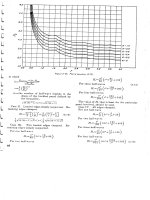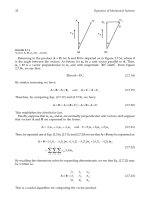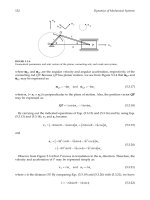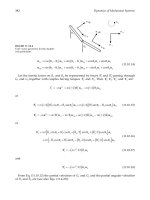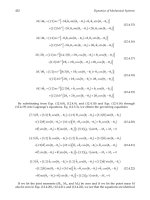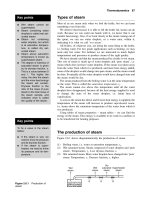Maintenance of Petroleum Systems B Episode 4 pot
Bạn đang xem bản rút gọn của tài liệu. Xem và tải ngay bản đầy đủ của tài liệu tại đây (318.29 KB, 15 trang )
UFC 3-460-03
21 JANUARY 2003
44
Figure 5.5. Pressure Relief Valve (50AF-2).
5.7.2. Pressure Setting. The 50AF-2 should be set at 10 psi above normal inlet pressure to the
90AF-8 (typical settings are in the range of 110 to 125 psi).
5.7.3. Recommended Setting Procedure for the Refueling Control (90AF-8) and Pressure Relief
Valve (50AF-2).
5.7.3.1. Set up system to refuel through the 90AF-8 valve.
5.7.3.2. Ensure a gauge is installed at the farthest hydrant outlet.
5.7.3.3. Be sure the CDHS-3 is in the cocked position.
5.7.3.4. Bottom both CRLs (90AF-8 and 50AF-2).
5.7.3.5. Energize the system and establish a smooth flow.
5.7.3.6. Adjust the 90AF-8 CRD until the gauge at the farthest outlet reads 105 psi.
5.7.3.7. Back off on the 90AF-8 CRL until the gauge needle dips (2 to 3 psi is acceptable).
5.7.3.8. Adjust the 90AF-8 CRD until the gauge at the outlet reads 100 psi (note the 90AF-8 inlet
pressure).
5.7.3.9. De-energize system.
5.7.3.10. Close a manual valve downstream of the 90AF-8 and shut off the 90AF-8 solenoid
switch.
5.7.3.11. Energize the system.
5.7.3.12. Back off on 50AF-2 CRL set screw until the valve starts to open and the inlet pressure is
10 psi above the normal inlet pressure recorded in paragraph 5.7.3.8 above.
5.7.3.13. De-energize the system.
5.7.3.14. Open the manual valve and turn on the solenoid switch (paragraph 5.7.3.10).
UFC 3-460-03
21 JANUARY 2003
45
5.8. Defueling Control Valve (134AF). The defueling control valve (Figure 5.6) is a diaphragm-
actuated solenoid shutoff valve. This valve and the defueling pump energize simultaneously. When the
valve is energized, it opens to permit defueling through the system.
Figure 5.6. Defueling Control Valve (134AF).
5.9. Dual Rate-of-Flow Control Valve (41AF).
5.9.1. The dual rate-of-flow control valve (Figure 5.7) is a combination rate-of-flow control valve
and fast-closing, hydraulically operated check valve that closes the main valve against reverse flow.
It performs two distinct functions: maintaining a preset flow rate of 757 liters per minute (200 gallons
per minute); and acting as a check valve to prevent reverse flow.
5.9.2. Pressure Setting. Set the valve to maintain a flow rate of 757 liters per minute (200 gallons per
minute) according to manufacturer’s guidelines.
UFC 3-460-03
21 JANUARY 2003
46
Figure 5.7. Dual Rate-of-Flow Control Valve (41AF).
5.10. Recommended Setting Procedure for Rate-of-Flow Control Valve (41AF).
5.10.1. With no pressure on the system, back off on the CDHS-2 and stop as soon as spring-tension
is lost.
5.10.2. Turn the adjusting screw clockwise two complete turns to get the lowest rate-of-flow setting
on the CDHS-2. NOTE: Never apply pressure to CDHS-2 if the adjusting screw has less than this
two-turn setting.
5.10.3. Set up the system to defuel through the 41AF.
5.10.4. Place the magnet on the defuel KISS switch.
5.10.5. Turn the CDHS-2 stem clockwise until you get a flow rate of 757 liters per minute
(200 gallons per minute).
5.10.6. Remove the magnet from the KISS switch.
5.10.7. Return the system to its original condition.
5.11. Defueling Pump. The defueling pump is installed in the hydrant LCP and used to pump fuel from
the aircraft into the designated defuel tank at the pumphouse. The defueling switch at the hydrant outlet
controls this pump. The self-priming centrifugal defueling pump (Figure 5.8) differs from a standard
centrifugal pump because a vane-type suction pump is mounted on the pump shaft. When the main
pump discharge pressure is below 10 psi, the priming pump is in the priming position (Figure 5.9). It
draws from the suction side of the pump and discharges at a point downstream of the check valve, so
priming the centrifugal pump. When the main pump discharge pressure reaches 10 psi, the priming
pump moves into the neutral position.
UFC 3-460-03
21 JANUARY 2003
47
Figure 5.8. Self-Priming Centrifugal Defueling Pump.
Figure 5.9. Centrifugal Priming Pump Operation.
UFC 3-460-03
21 JANUARY 2003
48
5.12. Remote Controls (Electrical and Magnetic). Remote control of fueling, defueling, and
emergency stop is performed by a three-element magnetic control KISS switch located near each
hydrant pit. A magnet controls each of the three functions. Placing the horseshoe magnet on either the
refuel or defuel KISS switch causes the appropriate pump to be energized. Usually a lanyard is attached
to the magnet for quick removal. A magnet in the cover over the emergency stop switch holds the
switch closed. By lifting the cover, the switch is deactivated and the system shuts down. Spring-loaded
covers over the refuel and defuel switches may be removed.
5.13. Hydrant Adapter and Liquid Control Valve (352AF).
5.13.1. The 352AF (Figure 5.10) provides a quick pressure-tight connection with the MH-2 hose
cart’s 351AF moosehead. The 352AF has a float assembly that controls the level of fuel maintained
in the piping at the end of defueling. The float keeps air from entering the system.
Figure 5.10. Hydrant Adapter (352AF).
5.13.2. During fueling operations, the 352AF float assembly is lifted from its seat as the float
chamber fills with fuel to open the valve. At the end of the defueling operation, the float chamber
drains and the float drops to close the valve, preventing air from entering the system.
5.13.3. A replacement poppet kit is available for the Cla-Val 352AF hydrant adapter. This kit must
be installed on all adapters to preclude a sticking problem encountered with the original poppet. The
poppet face will be stamped as MOD-1 if the kit is installed.
5.13.4. The API 364AF-2 hydrant adapter and its mating moosehead are industry-standard
replacements for the hydrant adapter of the 352AF and the 351AF moosehead. Replacing the older
UFC 3-460-03
21 JANUARY 2003
49
adapters must be a joint economic decision between the BCE and refueling maintenance as hydrants
and MH2 hose carts must be modified at the same time.
5.14. Hydrant Hose Cart. The MH2 hose cart contains an F/S and meter. Maintenance of hose carts is
the responsibility of refueling maintenance.
5.15. High Level Shut-Off (HLSO). The 124AF has been upgraded to the 129AF (Figure 5.11) by
installing an ejector and ball float assembly. The setting is the same as for a Type I system (279
millimeters [11 inches] from the top of the tank). See Chapter 10 for maintenance frequency.
Figure 5.11. HLSO Valve (129AF).
5.16. Type II Modified (Rapid Flow). The Rapid Flow modification was done at some bases to
increase defuel rates from 757 to 1135 liters per minute (200 to 300 gallons per minute) to speed the
turnaround of KC-135s and other large aircraft. A pump on the aircraft flows fuel from the aircraft
through the LCP and into the designated defuel tank. Hydraulic power for the pump comes from
operating one engine at idling speed. The defueling pump in the LCP is only used to evacuate the hose
cart after the aircraft pump is de-energized.
5.16.1. Combination Dual Rate-of-Flow Control, Solenoid Shutoff and Check Valve (41AF-10).
This valve (Figure 5.12) operates the same as the 41AF, with the addition of a solenoid for remote-
control operations. All settings and functions are the same as the 41AF.
UFC 3-460-03
21 JANUARY 2003
50
Figure 5.12. Combination Dual Rate-of-Flow Control Valve and Solenoid Valve (41AF-10).
5.16.2. Combination Dual Pressure Relief, Solenoid Shutoff and Check Valve (51AF-4):
5.16.2.1. General. The dual pressure relief valve (Figure 5.13) is installed in the modified hydrant
lateral control pit downstream of the refueling control valve between the hydrant lateral pipe line
and the defueling line (bypass piping around defuel pump, as shown in Figure 5.1). This relief
valve performs two functions: relieves excess pressure in the hydrant lateral piping caused by
quick-closing valves during the refueling operation; and maintains a minimum pressure of
5 psi on the hydrant lateral piping when the refueling pumps are not in operation. This valve also
has a CV flow control to slowly close the valve during rapid defueling operations.
UFC 3-460-03
21 JANUARY 2003
51
Figure 5.13. Dual Pressure Relief, Solenoid Shutoff, and Check Valve (51AF-4).
5.16.2.2. Operation. During rapid defueling operations, pressure supplied by the aircraft pumps
will open the low-pressure side of the 51AF-4 and provide thermal relief for the hydrant lateral
piping. When the refueling pumps are started the solenoid is energized, locking out the low-
pressure relief control and putting the valve under the command of the high-pressure relief control.
5.16.2.3. Pressure Setting:
5.16.2.3.1. When the refueling pumps are in operation, set the high-pressure CRL at
5 psi above the 90AF-8 CRL set point.
5.16.2.3.2. When the refueling pumps are stopped, set the low-pressure CRL at 5 psi.
5.16.2.3.3. Adjust the CV flow control closing speed to provide a smooth, pulsation-free
operation.
5.16.3. Recommended Setting Procedure for the Combination Dual Pressure Relief, Solenoid
Shutoff, and Check Valve (51AF-4).
5.16.3.1. Low-Pressure CRL Setting:
5.16.3.1.1. Place the magnet on the refueling KISS switch to pressurize the system (no hose
cart is need for this procedure).
5.16.3.1.2. When system pressure has built up and the refueling control valve (90AF-8) has
closed, remove the magnet from the refueling KISS switch.
5.16.3.1.3. The 51AF-4 should open and the system pressure should drop.
5.16.3.1.4. When the 51AF-4 closes, note the pressure gauge reading.
UFC 3-460-03
21 JANUARY 2003
52
5.16.3.1.5. If the pressure is more than 5 psi, slowly turn the adjusting screw counterclockwise
until the pressure drops to 5 psi.
5.16.3.1.6. If the pressure is less than 5 psi, turn the adjusting screw clockwise to raise the CRL
setting, then repressurize the system and adjust the CV flow control closing speed to provide a
smooth, pulsation-free operation.
5.16.3.1.7. Check the setting by starting and stopping the pump and checking the system
pressure.
5.16.3.2. High-Pressure CRL Setting:
5.16.3.2.1. Set up the system to dispense fuel through a hose cart to a truck.
5.16.3.2.2. Bottom the adjusting screw on the 51AF-4 high-pressure CRL.
5.16.3.2.3. Bottom the adjusting screw on the 90AF-8 CRL.
5.16.3.2.4. Place the magnet on the KISS switch to start the deep-well turbine pump.
5.16.3.2.5. Slowly turn the 90AF-8 CRD clockwise until the pressure gauge in the pit reads
5 psi above the normal setting of the 90AF-8 CRL.
5.16.3.2.6. Slowly turn the adjusting screw on the 51AF-4 high-pressure CRL
counterclockwise until the valve starts to open.
5.16.3.2.7. Stop and start the deep-well pump to recheck the setting.
5.16.3.2.8. Adjust the 90AF-8 CRD to 5 psi above NOP.
5.16.3.2.9. Adjust the 90AF-8 CRL counterclockwise until you get a 2- to 3-psi drop.
5.16.3.2.10. Adjust the 90AF-8 CRD to NOP.
5.16.3.2.11. Restore the system to original condition.
5.16.4. 358AF Hydrant Adapter. To conduct rapid defueling operations, the float assembly in the
352AF valve was removed. A 3.1-millimeter angle valve was installed in the tapped hole in the body
of the hydrant adapter to manually bleed off vapor and air. To prevent air from entering the system
when the hydrant is not in use, an X73 aluminum blanking cap, shown in Figure 5.14, has replaced
the rubber dust cover. A manual vacuum breaker was installed in the cap to dissipate any vacuum in
the adapter so the cap can be removed. This modified valve is called the 358AF hydrant adapter.
Figure 5.14. X73 Aluminum Blanking Cap.
UFC 3-460-03
21 JANUARY 2003
53
Chapter 6
CONSTANT-PRESSURE HYDRANT FUELING SYSTEM, TYPE III (PHILLIPS)
6.1. General Information. The constant-pressure hydrant fueling system is the newest system used by
the Air Force. It was conceived by the Phillips Petroleum Company in the mid-1950s to refuel military
transports and bombers, and has come into extended use since the mid-1980s. The standard Type III
system is designed for a maximum of 9085 liters per minute (2400 gallons per minute). Earlier systems
were designed as large as 22,712 liters per minute (6000 gallons per minute), but large pipe sizes, low
normal flows, and surge problems made these systems impractical. There have been some alterations to
this system design, but current standards are in DoD Standard Design 78-24-28-88-AF, Pressurized
Hydrant Fueling Systems Type III, available for download or in hard copy from the Corps of Engineers,
Huntsville Center (
). This system is constantly under pressure when
energized, and responds automatically to refueling and defueling requirements. Supervision is not
required at the pumphouse during the automatic mode if a “pump run” light and emergency shut-off
switch are provided at the RCC. Any number of aircraft parked along the fueling loop can receive fuel
simultaneously up to the flow capacity of the system. Additionally, aircraft can be defueled while others
are refueling. Because the system relies on pneumatically operated valves at the hydrants, the electrical
problems encountered with Type I and Type II systems do not exist. The heart of the Type III system is
the computer or microprocessor in the pumphouse control room, which controls the component
operation. A product recovery tank is provided to collect liquids from pressure reliefs, strainer drains,
F/S automatic drains (when used), low point drains, and the operating storage tank water draw-off
system. The Type III system has many components similar to those covered in the preceding chapters
under the Type I and Type II systems. The system includes filtration, aboveground operating storage, a
pumphouse, a control room, hydrant loop, a hydrant servicing vehicle (HSV) check-out stand, and
sometimes a fill stand. The pumphouse components include API Std 610 pumps, API horizontal F/Ss,
issue and return venturis, both direct-pressure and differential-pressure transmitters (DPT), and
automatic control valves. The loop also includes a hydrant control valve (HCV) at each hydrant. A
HSV is typically used between the hydrant outlet and the aircraft. Where filtration is not required at the
skin of the aircraft, a pantograph is acceptable.
6.2. Piping. As aircraft become more sophisticated, it is increasingly important to maintain fuel
quality, especially thermal stability. Contact with iron and steel degrades thermal stability; therefore,
the use of non-ferrous and coated materials is emphasized. For piping from the receipt F/S to the issue
F/S, only coated carbon steel, stainless steel, or aluminum (if not buried) may be used. For hydrant
systems, use stainless steel pipe downstream of the issue F/Ss. The F/S removes fuel degradation
products and degraded coating particles before they enter the loop. Stainless steel prevents fuel
deterioration and protects thermal stability. NOTE: All underground metal piping must be protected by
exterior coating and cathodic protection. In making pipeline repairs, take care when replacing or
repairing coatings. Even the most minuscule break in a coating can be a starting point for corrosion. Be
aware that buried stainless steel corrodes faster than carbon steel and must be treated carefully.
UFC 3-460-03
21 JANUARY 2003
54
6.3. Receiving and Storage.
6.3.1. Receiving Equipment. Typically, fuel is received at the base fuel storage area then delivered
to the Type III system by pipeline (Figure 6.1). Fuel enters the system through a 40-mesh strainer
upstream of the receipt F/S. This strainer is equipped with a piston-type DP gauge and a bottom drain
piped into a product recovery tank. The maximum allowable DP across the strainer is 10 pounds per
square inch differential. At 10 pounds per square inch differential, the operator must open and clean
the strainer. Once the fuel passes through the strainer, it moves through the receipt F/S or bypass
valve (BPV). The F/Ss are piped in parallel with a BPV and manifolded together. The receipt F/S is
an API 1581, Group II, Class B, and rated at 2271 liters per minute (600 gallons per minute) each.
The FSCV will close and the BPV will open automatically when the separator DP reaches 15 pounds
per square inch differential. After flowing through the receipt F/Ss or the BPV, fuel passes through
the 4542.4-liter-per-minute (1200-gallon-per-minute) meter, and then through the HLSO valve into
the operating storage tanks.
6.3.2. Storage Tanks. (See Figure 6.1.) Operating storage tanks have a cone roof, aluminum
honeycomb floating pan, and a 5% sloped floor to a center sump. These tanks are fully coated inside.
Existing storage tanks may be used as operating tanks when the distance from the Type III fueling
apron to the tanks is less than 1.6 kilometers and they are upgraded to the latest design standards for
operating storage tanks. New tanks must be constructed when the distance exceeds 1.6 kilometers.
Provide two tanks for each hydrant fueling system. Operating tanks typically have a capacity of 2500
barrels, 5000 barrels, or 10,000 barrels. Overseas, operating tanks are typically cut-and-cover tanks
(field-constructed underground storage tanks).
6.3.2.1. High-Level Alarm (HLA). (See Figure 6.1.) An HLA is installed on each tank to show
when the tank is full and further filling should stop. It is set to alarm just before the HLSO valve
closes to stop flow into the tank. When actuated, the HLA window on the pump control panel
(PCP) flashes and a vibrating alarm sounds. After the operator acknowledges the alarm, the audio
alarm stops and the visual warning becomes steady. Once the fuel level drops below the HLA
setting, the visual warning deactivates.
6.3.2.2. HLSO Valve (413AF-5A). Each operating storage tank is equipped with a HLSO valve on
the fuel inlet line and a float assembly at the tank high-level shut-off point (Figures 6.1 and 6.2).
When the tank fuel level reaches the float assembly, located on the side of the tank, the float
assembly directs fuel to the HLSO valve control loop, causing the HLSO valve to close and stop
the flow of fuel into the tank. The HLSO valve is equipped with a check feature to prevent reverse
flow. The float assembly also has a manual tester so the rotary disc assembly and the HLSO
valve-closing feature can be checked without filling the tank with fuel. Some HLSO valves have a
closing speed adjustment.
UFC 3-460-03
21 JANUARY 2003
55
Figure 6.1. Type III, Constant-Pressure Hydrant Fueling System.
UFC 3-460-03
21 JANUARY 2003
56
Figure 6.2. HLSO Valve (413AF-5A).
6.3.2.3. High-High-Level Alarm (HHLA). The float assembly for this alarm is above the HLSO
valve float assembly and below the tank overflow vents. This alarm indicates that both the HLA
and the HLSO have been ineffective and the tank is about to overflow. It actuates a flashing
HHLA window on the PCP and a resonating horn. After acknowledgment, the horn stops and the
window stops flashing, but stays lit until the level drops below the HHLA.
6.3.2.4. Low-Level Alarm (LLA). Each operating storage tank is equipped with a low-level float
assembly at the bottom of the tank. The LLA and shut-off switch controller will cause a visual
alarm at the annunciator panel and resonating alarm, and shuts down all fueling pumps when the
fuel level drops to the predetermined level.
6.3.2.5. HLA Test Procedure. Manually test the HLA and HHLA by isolating the float assembly
from the tank and filling it slowly with fuel until the HLA sounds the vibrating horn and the
HHLA sounds the resonating horn. Both alarms will activate visual alarms on the annunciator
panel. An audible alarm should also sound outside the building for both control systems. After
testing, drain the fuel from the float assembly through the drain valve before opening the tank
isolation valves. This prevents fuel from draining into the tank above the floating pan.
6.3.2.6. LLA Test Procedure. Test the LLA by isolating the float assembly from the tank and
draining it until the resonating horn and the visual alarms are activated at the annunciator panel
and outside the building. After testing, close the drain line and reopen the tank isolation valves.
6.3.2.7. Automatic Tank Gauges (ATG). All tanks handling jet fuel will have ATG installed. This
system is used for transfer and inventory control. The Petrol Ram division of the Air Force
Petroleum Office (AFPET), Fort Belvoir, Virginia, is the DoD agent for acquiring these systems.
Because of unique software requirements and the need to interface with the DoD Fuels Accounting
System (FAS), alternate systems must not be installed.
6.3.2.8. Outlet Valves. Each tank has a manual DBB valve at the tank outlet. In the Type III
system, one outlet valve must be open and one closed for the system to operate. The tanks are
equipped with a limit switch that illuminates a light on the system display panel that shows if the
UFC 3-460-03
21 JANUARY 2003
57
valve is open or closed. The microprocessor also uses this signal to find which tank should be
monitored for low-level conditions. The outlet lines from the tanks feed the pump suction
manifold in the pumphouse.
6.4. Pumphouse. This paragraph covers the pumphouse components, and will trace the flow of fuel
through the system during a refueling operation.
6.4.1. Fueling Pumps. Refueling pumps are 2271 liters per minute (600 gallons per minute), single-
stage centrifugal, horizontally mounted, vertical or radial split case, enclosed impeller, with end
suction and top vertical discharge conforming to API Std 610. They are statically and dynamically
balanced for all flow rates, from no flow to 120% of the designed rate.
6.4.2. Flow Switches. Typically, open flow switches are installed downstream of each pump
discharge. When there is flow, a vane in the pipeline is raised, rotating the attached shaft and closing
the double-pole double-throw snap-action switch, allowing the pump to continue to run. If flow is not
established within a preset time, the microprocessor calls off the unresponsive pump and calls on the
next pump in the start-up sequence.
6.4.3. Rate-of-Flow, Nonsurge Check Valve (41AF-1A).
6.4.3.1. This valve (Figure 6.3) is very similar to the nonsurge check valve used in Type I and II
systems, except it also provides flow control by using an orifice plate and DP controller. The flow
control is typically set for 2460 liters per minute (650 gallons per minute) to keep the pump from
operating outside its pump curve when one pump discharges into multiple F/Ss.
Figure 6.3. Rate-of-Flow Nonsurge Check Valve (41AF-1A).
6.4.3.2. Valve Setting. Set the CDHS-2B rate-of-flow control by turning the adjusting stem
clockwise to increase the fuel rate of flow and counterclockwise to decrease it. The valve should
be set for about 2460 liters per minute (650 gallons per minute). The valve-opening rate is set by
adjusting the CV flow control. Turn the CV flow-control adjusting stem clockwise to make the
main valve open slower and counterclockwise to make the valve open faster. Set the valve to open
UFC 3-460-03
21 JANUARY 2003
58
slowly so pressure surges do not damage the F/S and downstream equipment. The main valve
should open in about 20 seconds.
6.4.4. F/Ss. F/Ss are provided on both the receipt and issue side of Type III system storage tanks.
Issue F/Ss are manifolded together and share the discharge line from the issue pumps. These F/Ss are
rated for 2271 liters per minute (600 gallons per minute). See Chapter 3 for a detailed description.
6.4.5. FSCV (41AF-2C).
6.4.5.1. The only difference between the 41AF-2C (Figure 6.4) and the 40AF-2C (Figure 5.3),
used on the Type II system, is the 41AF-2C has check valves installed to prevent reverse flow.
The valve still controls the rate of fuel flow and closes when excess water is detected in the F/S.
Most bases have deactivated the water shut-off feature.
Figure 6.4. F/S Control Valve (41AF-2C).
6.4.5.2. Valve Settings. With one pump running and fuel flowing through one separator, turn the
CDHS-2 adjusting stem clockwise to increase the fuel flow through the valve and
counterclockwise to decrease it. Use the issue DPT to adjust the flow to about 2271 liters per
minute (600 gallons per minute).
6.4.6. Emergency Shut-Off (ESO) Valve (136AF-9B):
6.4.6.1. The ESO valve (Figure 6.5) has two solenoids that are energized when power is on,
enabling the main valve to open when there is fuel flow. Should power fail or an emergency stop
button be pushed, the solenoids will de-energize and the main valve will close within 10 seconds.
The valve also has a thermal relief feature that relieves excess cover chamber pressure back to the
valve inlet. Lastly, a differential relief is used to maintain a relatively constant DP between the
inlet and outlet of the main valve. The ESO valve feature is performed by alternate means for
designs completed since 1999.




